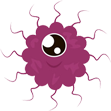Who lives in the pond?


After the rain, we can notice small ponds all around us. Depending on the season, some last for several months, while some evaporate with the first sun. Ponds are stagnant waters that are much smaller than a lake. Natural ponds usually arise in floodplains or along rivers. They may contain shallow water and aquatic plants and many animals live in them. Various microorganisms can also be found in the ponds. In addition to bacteria and viruses, there are heterotrophic protists that, like bacteria, cannot be seen with the naked eye. Paramecium and amoebae, as representatives of heterotrophic protists, are one of the main inhabitants of all ponds.
Paramecium
Back in 1675, naturalist scientist Antoni van Leeuwenhoek noticed under his microscope tiny organisms that moved vividly. One of the organisms was a 0.25 mm slipper animalcule. It was named after its shape which looked like a foot - a slipper. It belongs to the group of migratory animals, a class of ciliates, which are very widespread in freshwater terrestrial and marine environments. We call them protozoans because they appeared long ago in the evolutionary past and because probably all modern animals have evolved from their ancestors.
A is covered by a stick elastic structure called the pellicle, on which surface the cilia are used for moving and feeding. The pellicle also has a groove called the vestibulum. The vestibulum, i.e. oral groove, directs food into the cell mouth (cytostome) by which Paramecium feeds itself. The cell mouth is followed by a slightly more advanced digestive system, which includes the cell pharynx (cytopharynx) and the anal pore, or cytoproct, through which the undigested contents are expelled. When food enters the paramecium, a food bubble is created in which the lysosomes are poured and the food is digested by enzymes.
The Paramecium breaths by the exchange of gases that take place through the cell surface. Also, the paramecium has contractile vacuoles that serve as a mechanism for regulating the amount of water. The paramecium has a large nucleus called a macronucleus and a small nucleus called a micronucleus. The large nucleus controls feeding, gas exchange, and osmoregulation, and the small nucleus controls reproduction.
Find out in video file how Paramecium feeds.
Source - author: youtube.com - Craig Smith


Amoebae
Amoeba is also a protozoa belonging to the group of . Its characteristic is that it moves using false feet (pseudopods), i.e., it changes its body shape when moving. Amoeba is enclosed by the cell membrane, has a single nucleus, and feeds throughout the entire body surface.
As with the Paramecium, when the food enters, a food bubble is created around it, which associates with the lysosome and digests the food. The amoeba can survive adverse conditions (such as drought or cold) by forming a cyst. In the form of a cyst, the amoeba does not feed, move or reproduce, and waits for favorable conditions to return to a vegetative form. Amoeba feeds on bacteria, algae and slipper animalcules.
View more about Amoeba in video file.
Source - author: youtube.com - Dr. Ralf Wagner
The surface of the amoeba body is covered by a cell membrane. Amoeba doesn’t contain any additional structures on the cell membrane. The shape of an amoeba’s body is variable. It takes in food through the body surface by capturing its prey with false feet or pseudopods. When food enters the body, a food bubble forms around it. The food bubble associates with a lysosome that contains nutrient degradation enzymes. The undigested food is ejected out of the body of the amoeba. As with the paramecium, the amoeba gets oxygen by diffusion and uses contractile vacuoles for osmoregulation. The amoebae reproduce by binary fission, that is, by dividing the parent cell into two smaller ones, whereby the parent cell disappears.
View more how Amoeba feeds.
Source - author: youtube.com - 7activestudio
Some amoeba species live as parasites in the organs of different animals and humans. The most common pathogenic amoebae are and Acanthamoeba.

Do you want to know more?
Amoebae as “Trojan horses” of the microbial world
Should we watch out for amoebae and slipper animalcules carrying pathogenic bacteria?
Heterotrophic protists, such as amoebae and slipper animalcules, are found in almost every aquatic ecosystem on Earth. They mainly eat bacteria, and as their predators they can eat tens to hundreds of bacteria in just one hour. However, some bacteria have been able to develop certain traits that prevent the protist from digesting them after eating them, which allows them to survive within their host. Inside the protists, the bacteria find a safe shelter and protection from environmental hazards such as chlorination or, in some cases, antibiotics that could harm them.
Examples of such bacteria are , , , and many other bacteria. In this way, amoebae and slipper animalcules become "microbial Trojan horses" with a potential role in human and animal infection.
Illustration of Legionella pneumophila within Achantamoeba castellanii amoeba after 48 hours of cocultivation. The bacteria can be seen as dark blue sticks inside the amoeba.

Do not consume water found in the environment that doesn’t meet health safety standards as it may contain bacteria and amoebae!











